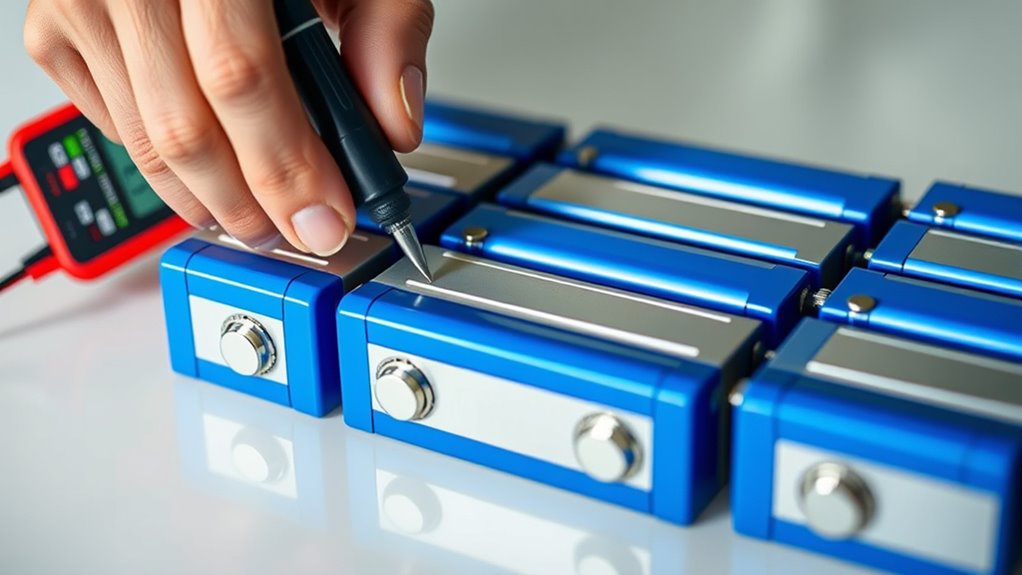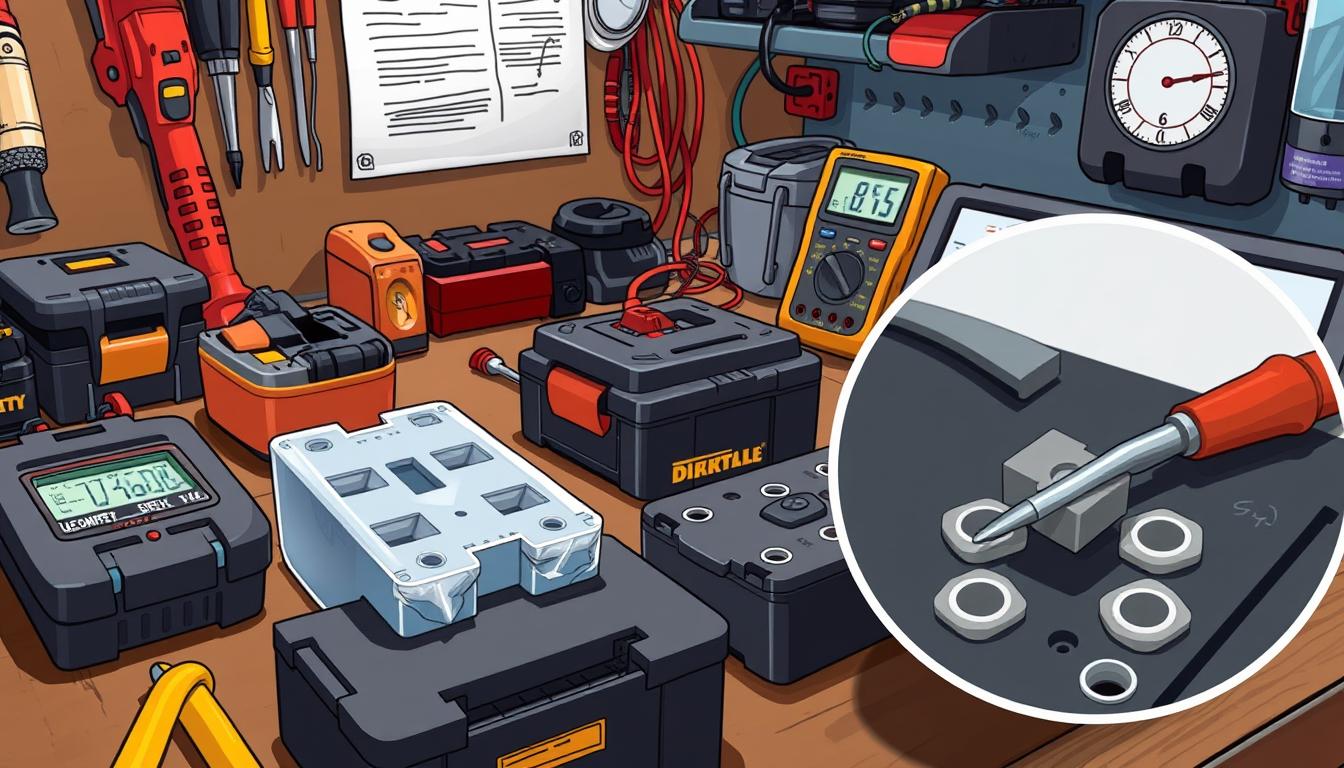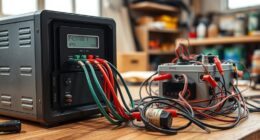Balancing battery packs involves ensuring all cells maintain the same voltage and state of charge, which is essential for safe, efficient, and long-lasting performance. When cells are balanced, you prevent overcharging, deep discharging, and uneven wear that can lead to permanent damage or safety hazards. Regular monitoring and utilizing effective balancing methods—whether passive or active—help keep your pack healthy. Keep exploring to discover how proper balancing can extend your battery’s lifespan and enhance safety.
Key Takeaways
- Balancing ensures all cells in a battery pack maintain equal voltage and charge levels.
- It prevents overcharging, deep discharge, and potential cell damage or safety hazards.
- Passive balancing dissipates excess energy as heat, while active balancing transfers charge between cells.
- Regular monitoring with a Battery Management System (BMS) triggers balancing to maintain uniformity.
- Proper cell equalization extends battery lifespan, enhances performance, and ensures safe operation.

Balancing battery packs is fundamental to guarantee each cell within the pack maintains the same voltage and state of charge. When cells are out of sync, it can lead to decreased performance, shortened lifespan, and even safety hazards. The process of cell equalization, often referred to as voltage balancing, is your main tool for ensuring uniformity across all cells. By actively managing the voltage levels, you prevent individual cells from becoming overcharged or deeply discharged, which can damage them permanently.
Voltage balancing can be achieved through different methods, but the core idea remains the same: equalize the charge among all cells. Passive balancing is the most common approach, where excess energy from higher-voltage cells is dissipated as heat through resistors. This method is straightforward and cost-effective, making it suitable for many applications. When you use passive balancing, you fundamentally bleed off some charge from the stronger cells, allowing weaker ones to catch up. This process may take some time, especially if there’s a significant imbalance, but it’s reliable and safe.
Active balancing, on the other hand, involves transferring charge directly from higher-voltage cells to lower-voltage ones, usually through inductors or capacitors. This method is more efficient because it conserves energy, reducing waste and speeding up the balancing process. If you’re working with high-capacity packs or need a quick turnaround, active balancing might be the better choice. It also helps maintain a more consistent overall voltage and extends the lifespan of your battery pack by preventing excessive stress on individual cells.
To effectively implement cell equalization, you should monitor the voltage levels regularly. Most modern battery management systems (BMS) include built-in voltage balancing features, automating the process and ensuring safety. When setting up your system, pay attention to the voltage thresholds that trigger balancing. If the voltage difference between cells exceeds a safe limit, the BMS kicks in to start equalization. This proactive approach keeps your pack healthy and prevents uneven wear, which could otherwise lead to premature failure. Regular monitoring and cell health assessments are essential to maintain optimal performance and longevity of your battery pack.
Frequently Asked Questions
How Often Should Battery Pack Balancing Be Performed?
You should perform battery pack balancing regularly, ideally every few months or after significant usage, to guarantee peak performance. Cell balancing methods are essential, and your battery management system (BMS) plays a key role in maintaining uniform cell voltage. By continuously monitoring and balancing cells, your BMS prevents overcharging or deep discharging, extending battery life and keeping your pack safe. Regular balancing keeps your battery pack reliable and efficient over time.
What Are the Signs of Uneven Cell Voltage?
Ever wonder if your battery pack has uneven cell voltage? You’ll notice signs like reduced capacity, faster charging times, or overheating during use. Cell voltage disparities can lead to uneven battery health, so regular monitoring is essential. Check for inconsistent voltage readings across cells, which indicate imbalance. If you spot these signs, it’s time to perform cell balancing to maintain peak performance and extend your battery’s lifespan.
Can Balancing Improve Overall Battery Lifespan?
Yes, balancing can improve your battery’s lifespan. When you perform cell monitoring, you identify uneven voltages, and voltage equalization helps bring all cells to a uniform level. This process reduces stress on weaker cells, prevents capacity loss, and minimizes the risk of overheating or failure. By maintaining consistent cell voltages, you extend the overall life and reliability of your battery pack, ensuring better performance over time.
Are There Risks Associated With Manual Balancing?
Are manual balancing risks worth taking? While it can help maintain cell consistency, manual balancing hazards exist. You might accidentally cause electrical shorts or damage cells if you’re not careful. Handling high voltages without proper knowledge or tools increases the chance of hazards. Always prioritize safety and consider automated balancing options—are you prepared to manage the risks involved? Proper precautions make all the difference in avoiding costly mistakes.
What Tools Are Recommended for Effective Balancing?
You should use tools like smart balancing chargers and cell monitoring systems for effective balancing. These tools utilize advanced charging algorithms to maximize charge distribution across cells, preventing overcharging or undercharging. Cell monitoring allows you to track voltage levels in real-time, ensuring uniformity. Combining these tools helps maintain balanced packs, prolongs battery life, and enhances safety. Regularly updating your tools and software ensures peak performance and accurate balancing results.
Conclusion
Remember, balancing your battery pack isn’t just a task—it’s the heartbeat of your system’s longevity. Think of each cell as a crucial note in a symphony; if one falls out of tune, the whole performance suffers. By maintaining uniform cell voltage, you guarantee harmony, efficiency, and a longer lifespan for your batteries. Don’t let imbalance be the silent thief of your power—take control and keep your energy singing in perfect harmony.









